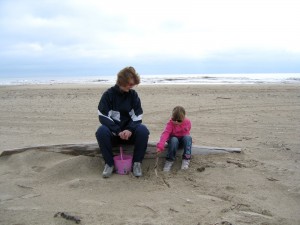 April 7, 2010
April 7, 2010
In the past couple of weeks, I have been watching the TV show that sparked some discussion on this blog a couple of weeks ago. After watching it so far [and with plans to continue to do so], I wanted to take note of a couple of points in his message that may be getting lost.
First, I heard Jamie say, “It is not about weight. …Thin people can be unhealthy, too.” This is a message about our health that gets lost in the clutter of messages about weight loss, dieting, obesity, and the fixation on what the scales say. Another time that I heard a similar message in a popular TV show was one year when the first dancer to be voted off ‘Dancing with the stars’ was a model. When she was rehearsing and then performing, she did not have the physical strength to pull herself up from some of the positions her partner placed her in. She was beautiful but as her expert dance partner said, “She is deceptively unfit.” So, yes, it is NOT about the weight. If we could follow more of the fitness model and less of the weight model, a healthy weight would likely be one of the outcomes. This is one of the great messages being communicated by Michelle Obama… to the kids of the U.S., get out and get up and get moving. To the rest of as adults who set role models for our youth and for our friends and family and coworkers, ditto… I talk about this in my book ‘Talking about health’ when I tell my own experience with sitting at the computer for too many hours over too many years and developing bone spurs in my neck–literally a stiff neck. I talk about how our generation of computer workers is not unlike the old factory and production line works in that we are in one position for too long and literally get stiff [and a little fat from it, too]. My physical therapist told me, ‘Never sit at the computer for more than 30 minutes without getting up and taking a stretching break for at least 2 minutes.’ He told me to set a timer and I do–at home and at the office. Get moving and make it fun!
A second message from Jamie Oliver’s show that we should hear and act on has to do with the how over processed our foods have become. We have given the food industry a profit motivation to come up with products for us to purchase that say on them such things as ‘fat free’ or ‘no sugar added.’ A long list of ingredients then includes a lot of long words that none of us recognize because they have mostly been created in food laboratories. I was shocked when Jamie showed a class of youngsters various vegetables and the kids could not name a ‘tomato’ or a ‘potato.’ They knew what french fries are but not what a potato looks like. Wow! A shout-out to those writing the ABC picture books. We need to put some vegetables in one. Perhaps an entire picture book devoted to vegetables. And then, of course, it would be great if we followed up by eating some of these vegetables. On this blog a couple of weeks ago when the Jamie Oliver show was brought up by a participant, it was noted that the cost of fresh vegetables is high. The cost of frozen vegetables may be a good substitute. One of the partipants in that discussion said that she could buy a bag of mixed frozen vegetables in the store brand for $1 and feed her family of four with it. I suspect that the store advertises that product with an emphasis on the cost rather than the nutrition. We need more communication about how to use frozen affordable vegetables when fresh ones are not an option.
Third, following on the heels of our food being over processed is a message about our foods containing too much salt. Most of us know that the ‘dead sea’ doesn’t support any life because the water is too salty. Well, when we get too much salt, our health doesn’t do well. That is one of the challenges of buying frozen vegetables. We still have to look at the product to see if anything has been added. Not all frozen vegetables are created ‘equal.’ Some of them have salt added. So it is not just the long scientific chemical names to watch out for when looking at nutrition labels and the ingredients of products, we need to watch out for ‘sodium’–salt that has been slipped into the ingredients. We can change the way products come to us. We change them with the votes of our dollars–our food purchasing dollars…

 March 30, 2010
March 30, 2010
 March 1, 2010
March 1, 2010 February 27, 2010
February 27, 2010 February 18, 2010
February 18, 2010 Taking vitamins is the number one way that
Taking vitamins is the number one way that  February 9, 2010
February 9, 2010
 January 31, 2010
January 31, 2010 January 21, 2010
January 21, 2010